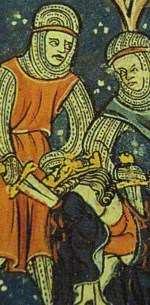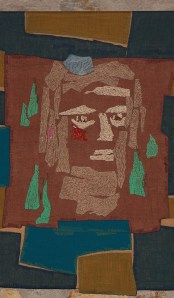During the murdering of Julius Caesar, Cassius Longinus wounded the pontifex maximus obliquely across his face. This sacrilege and profanation in the eyes of the people aroused outrage and deep indignation. They never forgot…
.
Nicolaus Damascenus, Bios Kaisaros 24.89 (ca. 20 BCE):
– Κάσσιος ὑποφθὰς εἰς τὸ πρόσωπον ἐγκαρσίαν αὐτῷ πληγὴν δίδωσι
– Cassius had struck him obliquely across the face
– Mais, plus rapide que lui, déjà Cassius l’avait frappé à travers la figure
– Kurz vorher hatte Cassius ihm einen Hieb quer über das Gesicht versetzt
Nicolaus Damascenus, Bios Kaisaros 26.97 (ca. 20 BCE):
– τὰϛ ἑπὶ τοῦ προσώπου πληγάϛ
– the wounds on the face
– son visage couvert de blessures
– die Hiebe in seinem Gesicht
Ovidius, Fasti 3.706 (< 8 CE):
– polluerant pontificale caput
– defiled the high priest’s head
– ont profané la tête d’un pontife
– Sich an dem Priesterhaupt schändlich vergriffen
Appianus, Bella Civilia 2.117 (ca. 150 CE):
– Κάσσιος ἐς τὸ πρόσωπον ἔπληξε
– Cassius wounded him in the face
– Cassius le blessa au visage
– Cassius verwundete Caesar im Gesicht
Appianus, Bella Civilia 2.147 (ca. 150 CE):
– καὶ σφαγαὶ τρεῖς καὶ εἴκοσιν ὤφθησαν ἀνά τε τὸ σῶμα πᾶν καὶ ἀνὰ τὸ πρόσωπον θηριωδῶς ἐς αὐτὸν γενόμεναι
– showing the twenty-three wounds in all parts of the body and on the face, that had been dealt to him so brutally
– et l’on y vit les vingt-trois blessures qui lui avaient été portées sauvagement sur tout le corps et au visage
– und es zeigte am ganzen Körper sowie im Gesicht dreiundzwanzig grausam beigebrachte Wunden
.
Ivory casket, detail
(British Museum ca. 420)
.
“Salve caput cruentatum”
(Arnulf van Leuven, ca. 1235)
.
Cassius stiet hem opt gelaet
(Jacob van Maerlant, ca. 1286)
.
“O Haupt voll Blut und Wunden”
(Paul Gerhardt, 1656)
.
“O Head so full of bruises.”
(John Gambold, 1752)
.
.
Wandteppich
(Greta Badenheuer, 21st Century)


